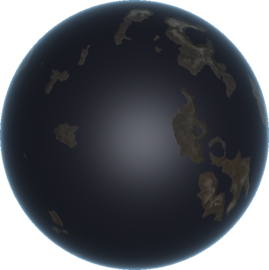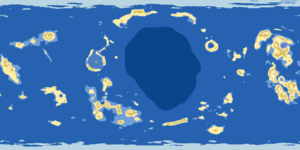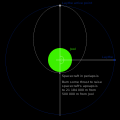Difference between revisions of "Laythe"
(someone with more time than me should fix all the atmosphere stuff) |
|||
| Line 31: | Line 31: | ||
== Atmosphere == | == Atmosphere == | ||
| − | Laythe's [[atmosphere]] begins at | + | Laythe's [[atmosphere]] begins at 50,000 meters and is 40% thinner than Kerbin's. It is the only moon in the game which has an atmosphere. |
Like all other atmospheres in the game, Laythe's atmosphere fades exponentially with increasing altitude (with a scale height of 4000 m). In general, the atmospheric pressure on Laythe at an altitude expressed in meters is:<ref>A [[LV-N Atomic Rocket Motor]] has a specific impulse of 220 in 1 atm, 800 in vacuum, and the following at various Laythe altitudes: | Like all other atmospheres in the game, Laythe's atmosphere fades exponentially with increasing altitude (with a scale height of 4000 m). In general, the atmospheric pressure on Laythe at an altitude expressed in meters is:<ref>A [[LV-N Atomic Rocket Motor]] has a specific impulse of 220 in 1 atm, 800 in vacuum, and the following at various Laythe altitudes: | ||
| Line 81: | Line 81: | ||
== Changes == | == Changes == | ||
| + | ;{{Version|1.0|}} | ||
| + | *Atmosphere reduced | ||
;{{Version|0.90|}} | ;{{Version|0.90|}} | ||
* Added biomes | * Added biomes | ||
Revision as of 22:42, 3 May 2015
| Laythe | ||
| Laythe as seen from orbit. | ||
| Moon of Jool | ||
| Orbital Characteristics | ||
| Semi-major axis | 27 184 000 m [Note 1] | |
| Apoapsis | 27 184 000 m [Note 1] | |
| Periapsis | 27 184 000 m [Note 1] | |
| Orbital eccentricity | 0 | |
| Orbital inclination | 0 ° | |
| Argument of periapsis | 0 ° | |
| Longitude of the ascending node | 0 ° | |
| Mean anomaly | 3.14 rad (at 0s UT) | |
| Sidereal orbital period | 52 981 s | |
| 2 d 2 h 43 m 0.9 s | ||
| Synodic orbital period | 53 007.7 s | |
| Orbital velocity | 3 224 m/s | |
| Longest time eclipsed | 3 754 s | |
| Physical Characteristics | ||
| Equatorial radius | 500 000 m | |
| Equatorial circumference | 3 141 593 m | |
| Surface area | 3.1415927×1012 m2 | |
| Mass | 2.9397311×1022 kg | |
| Standard gravitational parameter | 1.9620000×1012 m3/s2 | |
| Density | 56 144.728 kg/m3 | |
| Surface gravity | 7.85 m/s2 (0.8 g) | |
| Escape velocity | 2 801.43 m/s | |
| Sidereal rotation period | 52 980.879 s | |
| 2 d 2 h 43 m 0.9 s | ||
| Sidereal rotational velocity | 59.297 m/s | |
| Synchronous orbit | 4 686.32 km | |
| Sphere of influence | 3 723 645.8 m [Note 1] | |
| Atmospheric Characteristics | ||
| Atmosphere present | Yes | |
| Atmospheric pressure | 60.7950 kPa | |
| 0.6 atm | ||
| Atmospheric height | 50 000 m | |
| 6.0×10-7 atm | ||
| Temperaturemin | -74.15 °C 199 K | |
| Temperaturemax | 3.85 °C 277 K | |
| Oxygen present | Yes | |
| Scientific multiplier | ||
| Surface | 14 | |
| Splashed | 12 | |
| Lower atmosphere | 11 | |
| Upper atmosphere | 10 | |
| Near space | 9 | |
| Outer space | 8 | |
| Recovery | 8 | |
|
| ||
Laythe is the first of the five natural satellites of Jool. Although mostly covered in seas, Laythe has numerous rocky, sandy islands. Laythe is tidally locked to Jool. Synchronous orbits around Laythe are not possible, as they would lie outside of its SOI, at a radius of 5,186,399 meters. A circular archipelago prominent in surface maps of the moon suggests that Laythe suffered a massive impact in its distant past.
Achieving a stable orbit around Laythe from sea level requires a delta-V of ≈2800 m/s.
Laythe has no real-world analogue. In the real-world Jupiter system, the moons Ganymede, Europa and Io form a group with an orbital resonance just like KSP's Tylo, Vall and Laythe. But while Tylo and Vall have a certain resemblance to their real-life counterparts, Laythe is very unlike the volcanic, atmosphere-less, dry Io. Instead, the presence of a liquid ocean - plus a dense atmosphere - makes Laythe more similar to the Saturnian moon, Titan. Laythe also seems very similar to what happened to Europa in 2010: Odyssey Two.
Although Laythe has liquid water on its surface, the temperature there is below zero degrees Celsius. This means that Laythe's oceans must contain another compound, most likely ionic, such as salt. Surface samples indicate that much salt is present on Laythe's surface. Unlike that of Kerbin, the air cannot be breathed by Kerbals (according to EVA reports). It is therefore possible that there are also high concentrations of salt in the air, as well as on the surface, assuming that the salt is sodium chloride. The apparent toxicity of Laythe's atmosphere, despite being similar in composition to Kerbin's, may also be a reference to the film Avatar - the moon Pandora is very similar to Earth, but its atmosphere is too toxic for humans to inhale, and the moon also orbits a gas giant, like Laythe.
According to former developer NovaSilisko, Laythe was planned to have volcanic, probably cryovolcanic, activity and high radiation levels in later versions, making it a much more hostile moon than in 0.23.[1][2]
Contents
In-game Description
| “ | When Laythe was first discovered, it was not entered in the records because the scientist in charge thought he was looking at Kerbin. Luckily this error was corrected when a plucky intern informed him that telescopes don’t work that way. The intern was shortly afterwards promoted and moved to the experimental rocket testing program. — Kerbal Astronomical Society |
” |
Biomes
Laythe has 4 biomes. Laythe exists of a huge ocean, called The Sagen Sea, with some small Dunes and Shores biomes. It also has a Poles biome. There is also a rumour of a biome called "Cresent Bay", but as of 0.90, until proven otherwise, it's not reachable.
Biome list
|
Atmosphere
Laythe's atmosphere begins at 50,000 meters and is 40% thinner than Kerbin's. It is the only moon in the game which has an atmosphere.
Like all other atmospheres in the game, Laythe's atmosphere fades exponentially with increasing altitude (with a scale height of 4000 m). In general, the atmospheric pressure on Laythe at an altitude expressed in meters is:[3]
With proper aerobraking near Laythe and Jool, reaching Laythe may require the least delta-V of all of Jool's moons. When approaching Jool on a Hohmann transfer orbit from Kerbin, aerobraking with a Jool periapsis of 119.5 km will put your apoapsis roughly near Laythe's orbit.
Another way is to approach Laythe directly, utilizing proper timing and making orbital adjustments on the way to Jool. Laythe's orbital period makes it an easy target to time and will have required less delta-v on arrival (only 2000 m/s). As such, aerobraking on Laythe is less extreme than on Jool.
Landing on higher points of Laythe's surface has to be done with the help of retro-burns, as parachutes alone will not suffice to sufficiently lower a craft's velocity for landing.
Jet engines work in Laythe's atmosphere due to the presence of oxygen. However, the air-intake efficiency is lower there.
Most of Laythe's surface is ocean. There are many craters on its surface, and some of the largest features it has may be related to impacts. Other features on the surface, such as small canyons, may have been carved out by flowing water that either came up through the surface or fell as rain when the planet was warmer.
Science
Laythe is the most science-rich body in the Joolean moon system. Even though Tylo has a slightly higher science multiplier for both surface and orbit, Laythe's atmosphere and oceans allow a lot more experiments to be performed, which means the total science output is higher.
Reference Frames
| Time warp | Minimum Altitude |
|---|---|
| 1× | Any |
| 5× | 50 000 m (above the atmosphere) |
| 10× | 50 000 m (above the atmosphere) |
| 50× | 60 000 m |
| 100× | 120 000 m |
| 1 000× | 240 000 m |
| 10 000× | 480 000 m |
| 100 000× | 600 000 m |
Gallery
Changes
- Atmosphere reduced
- Added biomes
- Initial Release
Notes
- ↑ Forumpost from NovaSilisko
- ↑ Post from NovaSilisko
- ↑ A LV-N Atomic Rocket Motor has a specific impulse of 220 in 1 atm, 800 in vacuum, and the following at various Laythe altitudes:
altitude (m) 600 1464 1800 2238 2698 3296 4104 16435 specific impulse 400.7 478.2 504.2 534.8 563.7 596.5 633.7 792.4



















